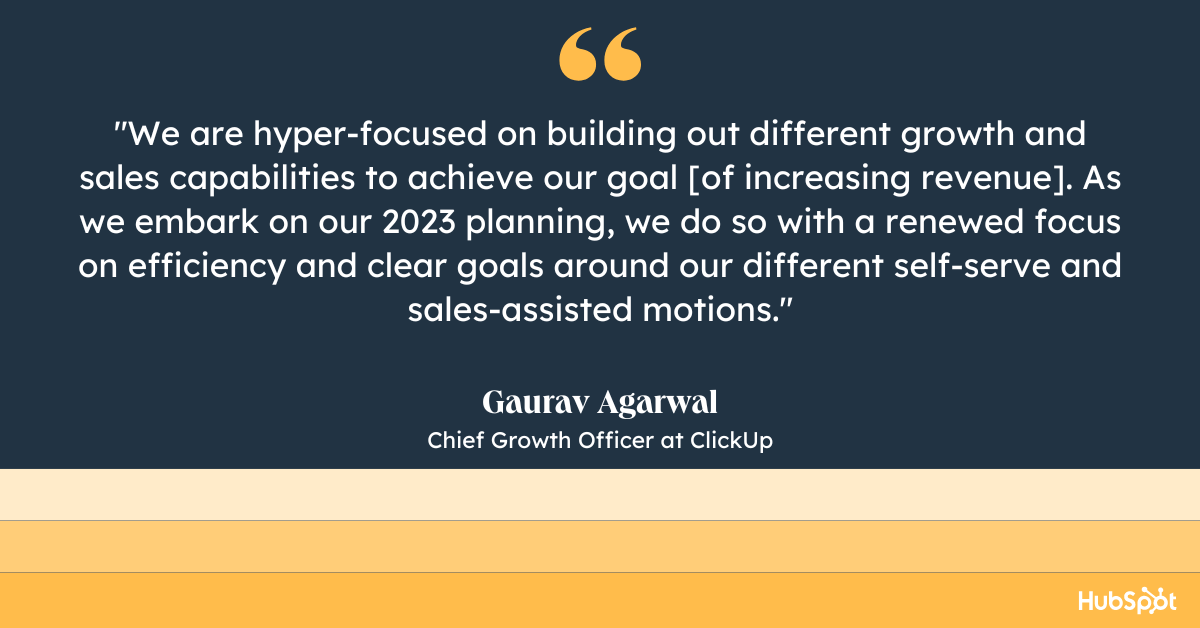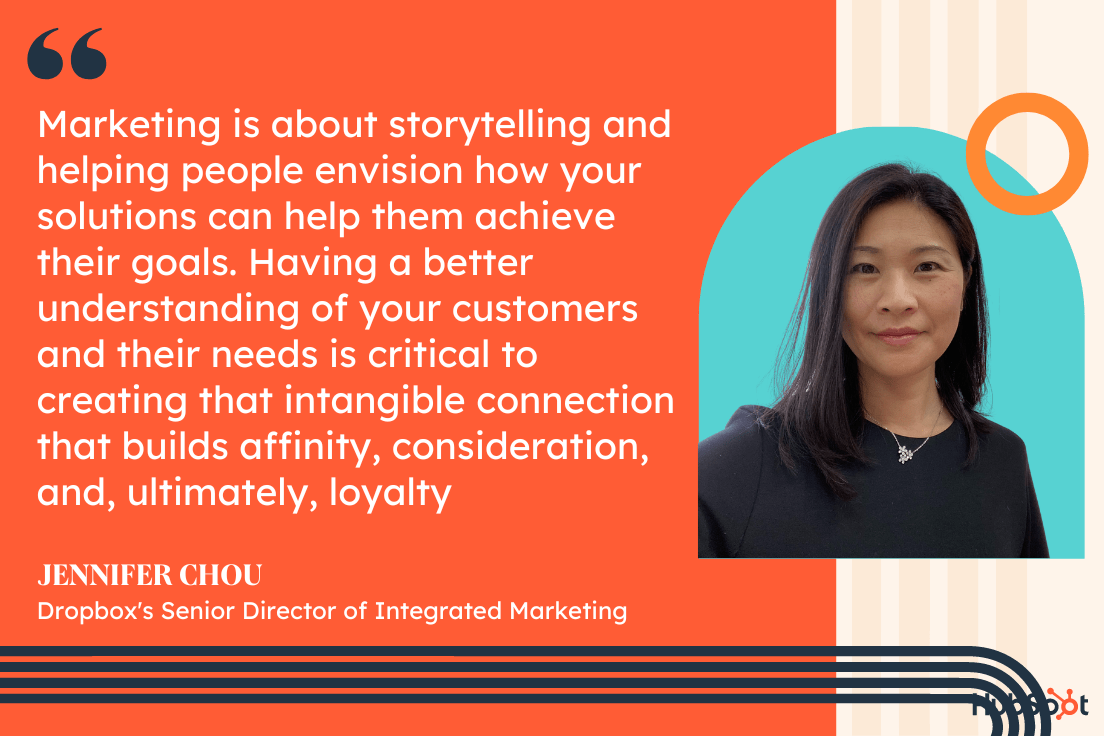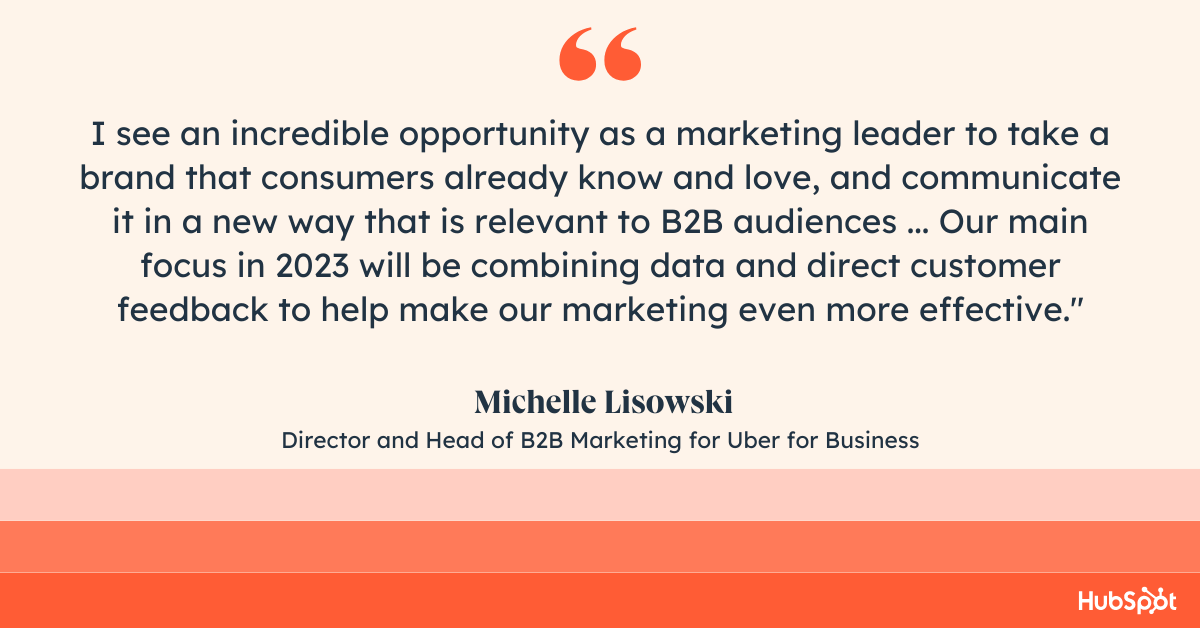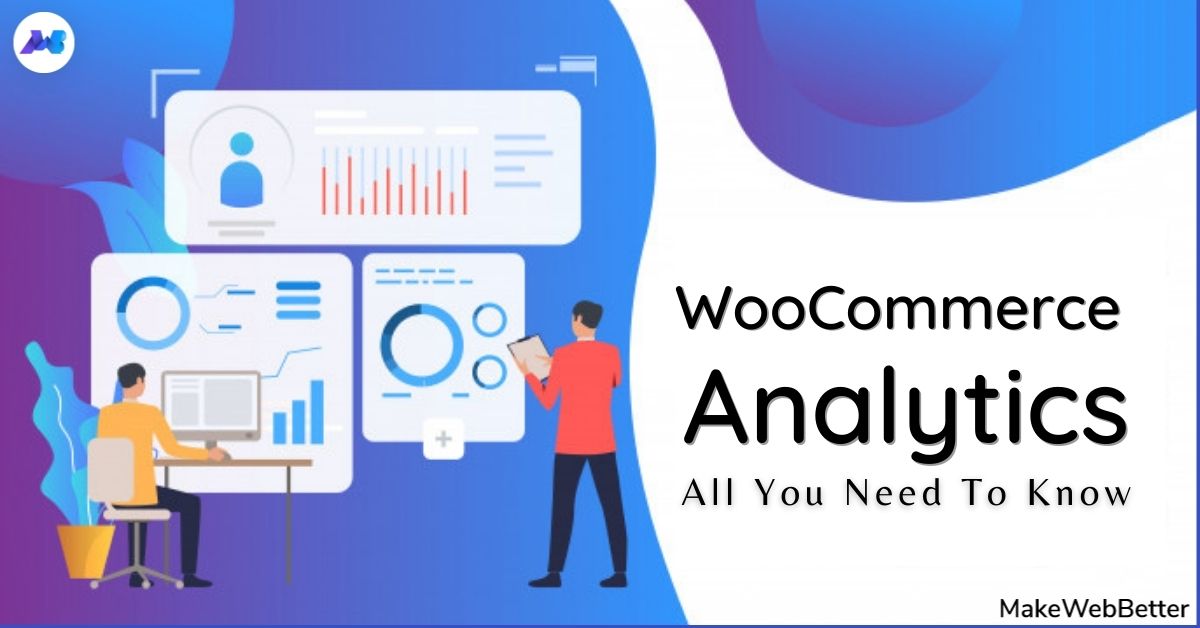The Top Goals of Marketing Leaders in 2023 [New Data + Expert Insights from Uber, Dropbox, and ClickUp]
To effectively lead a marketing team, it's imperative you know your top goal.
![The Top Goals of Marketing Leaders in 2023 [New Data + Expert Insights from Uber, Dropbox, and ClickUp]](https://blog.hubspot.com/hubfs/marketing%20leader%20challenges.png#keepProtocol)
To effectively lead a marketing team, it's imperative you know your top goal. Whether your goal is to increase revenue or improve your customer's understanding of your products, starting with a clear objective will help you map out a strong strategy for 2023 and beyond. But it can be difficult to identify the most important goals for your organization — which is why we surveyed 500+ marketing executives to find out the goals that matter most to them. About half of marketing leaders say they will change their marketing goals in 2023. Here, we'll take a look at the top five goals those marketing leaders plan to prioritize in the upcoming year. Plus, hear from experts at Uber, Dropbox, and ClickUp on how to achieve them. 22% of marketing leaders report 'increasing revenue and sales' as their top priority for 2023. It should come as no surprise that increasing revenue is a top goal for many marketing leaders. At its core, a marketer's job is to impact a business' bottom line by attracting the right audiences and driving leads further down the pipeline for sales. Gaurav Agarwal, Chief Growth Officer at ClickUp, told me increasing revenue and driving sales is a top priority for his team as we enter the new year. He says, "As a fast-growing company with industry-leading NDR, adding in new revenue sustainably is our top priority. We are hyper-focused on building out different growth and sales capabilities to achieve that goal. As we embark on our 2023 planning, we do so with a renewed focus on efficiency and clear goals around our different self-serve and sales-assisted motions." Agarwal continues, "We are also doubling down on organic growth strategies and efforts to better monetize our user base and leads. It is our priority to take a full-funnel approach to build compounding revenue machines." To increase revenue, marketing leaders need to identify areas of their customer journey that can be further optimized. Additionally, like Agarwal and ClickUp, marketing leaders will want to focus on lead generation. There is no one-size-fits-all approach to effective lead generation. To improve your lead generation strategy, you might test out new landing page CTAs, try creating stronger offers, or re-focus your efforts on more powerful lead nurturing campaigns. It's also important to continually test new platforms — like TikTok, or podcasting — to reach new audiences. Michelle Keene, Dropbox's Sr. Director of Global Marketing, Document Workflows, told me that increasing revenue is a top goal of hers for 2023. As she puts it, "In 2023, a year that is expected to be dominated by economic uncertainty, the shift to profitable growth [rather than growth at all costs] will only be accelerated — moving from a nice idea to a requirement." To combat this challenge, Keene offers five key principles for marketing leaders to follow: 1. Move from a revenue-only goal to a revenue and cost-of-acquisition goal. 2. Find technology solutions that enable CAC measurement at the program level. 3. Evolve your marketing attribution models. 4. Deeply understand your target audiences and their needs to deliver the right messages at the right time. 5. Encourage ongoing deployment of hypothesis-driven experiments and optimizations. She adds, "As a marketing leader, I am embracing this challenge, making efficient growth a top priority in 2023. While any mindset shift is challenging, the benefits far outweigh the change management costs. It can transform the way senior executives view marketing — not as an expense, but as an investment — which is really empowering and energizing for me." Ensuring your marketing team is strongly aligned with sales is a critical component of hitting and even exceeding revenue goals. In fact, organizations with tightly aligned sales and marketing teams are 6% more likely to exceed revenue goals. Which is why 19% of marketing executives say improving sales alignment is a top goal of theirs for 2023. To foster better alignment, consider asking your sales and marketing teams to create your buyer personas together. Sales teams have unique insights into prospects since they speak with them on a daily basis. By partnering with sales teams, you're able to create a more comprehensive picture of your target persona — including specific challenges or pain points you might've missed in your marketing research. You might also consider working with the sales team to get their input on any content gaps in the buyer's journey. For instance, a sales rep might point out that you don't have enough e-books or blog posts that speak to a specific challenge many of your customers have. By working directly with the sales team, you can create a more seamless buyer experience and retain customers by ensuring you're consistently creating the content they need to succeed. Out of the marketing executives who said they're changing their goals in 2023, 19% report 'fostering relationships with customers and increasing brand loyalty' to be their new top priority. Customer experience matters more than ever because your happiest customers become the strongest marketers for your brand. A satisfied customer will share their positive experiences online and with friends and family. And people are most likely to trust recommendations from people they know. Plus, according to an RRD survey of 1,000 consumers, 40% of consumers make purchases based on word-of-mouth recommendations. All of which is to say: How your customers feel about your brand matters greatly for your bottom line — so it's vital you do everything you can to foster stronger relationships with them. Jennifer Chou, Dropbox's Senior Director of Integrated Marketing, believes having a strong understanding of your customers is a vital first step in building brand loyalty. She told me, "Marketing is about storytelling and helping people envision how your solutions can help them achieve their goals. Having a better understanding of your customers and their needs is critical to creating that intangible connection that builds affinity, consideration, and, ultimately, loyalty." She continues, "Customers want to relate to companies in new ways and feel that connection that this company understands what I’m dealing with, and is building products for me. This is truly important for us as we think about 2023. Dropbox has so much more to offer with our newest products and features. We are enabling better workflows around our users' content. This means we need to know their challenges and goals as well or even better than they do, so they can focus on the work that matters." (P.S. Are you already a Dropbox customer? If so, click here for 20% off eligible HubSpot products, or sign up for free.) To cultivate a strong relationship between your brand and its community, you'll also want to make sure your marketing materials convey your brand's values. People will feel more connected to your business if they believe that your company cares about issues that matter most to them. As Daniel Godoy, Microsoft's Global Head of Programmatic Evangelist puts it, "The best way to win trust is by putting upfront the values your brand cares about, and having transparent communication that highlights your purpose commitments. According to Microsoft Advertising Research, 85% of consumers only consider brands they trust. And 72% only support brands that are being authentic in their advertising." Additionally, try creating opportunities for your customers to interact with each other. For instance, you might create a Facebook group so your customers can engage with each other, share industry best practices, and get ideas or suggestions to help them work through their business challenges. HubSpot's Social team created a Facebook group and have since leveraged the group to foster a stronger sense of community among its members. Finally, you'll want to make sure you create a strong online customer support experience. Among other best practices, consider investing in a CRM, offering omnichannel support via email, phone, online chat, or social media, and training your customer service reps to use customer interactions as opportunities to build brand loyalty. 19% of marketing executives want to focus on advertising their products and services effectively in 2023. Advertising isn't what it used to be. This isn't the days of Mad Men's Don Draper and creating quippy billboard slogans — at least, not entirely. Beyond the more classic channels like print, TV, radio, and direct mail, many brands now advertise almost exclusively on digital platforms. Digital advertising is incredibly effective for reaching large audiences for a relatively low cost compared to more traditional methods, like TV. Many digital advertising platforms offer helpful tools for empowering marketers to create engaging ads and iterate quickly if something isn't working. Google's responsive ads feature, for instance, tests various headlines and descriptions and ultimately displays the combination that performs best with an intended audience. Social media is another powerful option for advertising in 2023. To create a strong social media advertising strategy, you'll want to: Take a look at this post to learn more about how to create a strong social advertising strategy. Finally, 19% of marketing executives hope to improve their customers' understanding of their products or services in 2023. This goal resonates with Michelle Lisowski, Director and Head of B2B Marketing for Uber for Business. She told me, "I see an incredible opportunity as a marketing leader to take a brand that consumers already know and love, and communicate it in a new way that is relevant to B2B audiences. Building this kind of strategy requires taking our buyers’ unique needs and wants into consideration. We have to help them see how Uber products and services can enhance everyday work experiences, whether it's traveling for business or ordering afternoon coffee for delivery right to the office." Lisowski continues, "In many ways, our team acts like a B2B startup in a large, consumer-oriented company. We have the benefit of being able to plug into established marketing channel teams and expertise, but still need to build go-to-market motions that will resonate with our enterprise audience. Our main focus in 2023 will be combining data and direct customer feedback to help make our marketing even more effective. Ultimately, we want to generate trust and familiarity through one-to-one engagements that build lasting customer relationships." If your business is branching out into new markets, it's vital you take the time to understand your new consumers so you can effectively show them how your product can solve for them. A full one-third of consumers prefer to learn about products by searching the internet, so to improve your customers' understanding of your products or services, you'll want to start with a strong SEO strategy. Creating product-relevant content can help your prospects get to know your products on a deeper level and help them succeed after they've purchased. Additionally, a good SEO strategy can help you demonstrate what your product is to people who haven't heard of your brand before. Let's say you work for a video editing company. By writing content like "Why Video Marketing Matters" and "5 Ways to Create Higher-Quality Videos", your audience will begin to understand that your company is in the video industry. Once readers have found value in your content, they'll explore your site further. This is where it's vital to have knowledge-base articles to help interested prospects fully understand all the unique features your product offers. Social media is another good contender for developing an understanding of your products or services. In fact, if you're marketing to Gen Z or millennials, it's imperative you use social media for product education, since social media is Gen Z's favorite channel for learning about new products, and it's millennials' second favorite (right behind search engines). While those are the top five goals shared by marketing leaders, I'd like to highlight an additional five for consideration. These include: Ultimately, determining your top goal for the new year will help you lead your team more effectively and stay focused on your north-star metrics as the year progresses. Plus, knowing your goal will help you plan accordingly — including where to allocate budget and resources, who you might need to hire, and areas for improvement in your current strategy.
Learn from industry leaders on how to take your team to the next level in 2023, plus take a look at data from 300+ marketing directors.
The Top 5 Goals of Marketing Leaders in 2023
1. Increasing revenue and sales.


2. Improving sales and marketing alignment.
3. Fostering relationships with your customers and increasing brand loyalty.

4. Advertising your products or services.
5. Improving customers' understanding of your products and services.


 Tfoso
Tfoso 

































